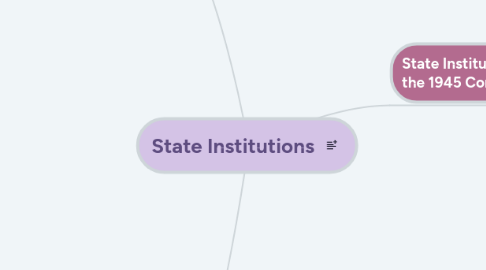
1. State Institutions according to the 1945 Constitution
1.1. Majelis Pemusyawaratan Rakayat
1.1.1. DPR and DPD members elected through general elections
1.1.2. amends and stipulates the 1945 Constitution
1.1.3. membership formalized by presidential decree
1.1.4. 5 years
1.2. President
1.2.1. head of state and government
1.2.2. authorized to form a cabinet and appoint ministers
1.2.3. minister is helper and can't join the parliament
1.2.4. minister is responsible only to the president
1.2.5. length of service depends on president
1.2.6. parliament as legislatif and president as executive is balanced
1.3. Dewan Perwakilan Rakyat
1.3.1. political parties in general elections
1.3.2. 560 people
1.3.3. membership formalized by presidential decree
1.3.4. 5 years
1.4. Badan Pemeriksa Keuangan
1.4.1. chairman, deputy of chairman, and 7 members
1.4.2. 9 people
1.4.3. 5 years (can be re-elected once)
1.5. Mahkamah Agung
1.5.1. a leader, member judges, clerks, and a secretary
1.5.2. 60 people
1.5.3. 5 years
1.6. Mahkamah Konstitusi
1.6.1. chairman, vice chairman, and 7 members
1.6.2. 9 members
1.6.3. judge at at first and last level, decisions are final
1.6.4. 2.5 years
1.7. Dewan Perwakilan Daerah
1.7.1. representatives from each province through general election
1.7.2. 4 people/province
1.7.3. 5 years
1.8. Komisi Yudisial
1.8.1. chairman and vice chairman
1.8.2. 7 people
1.8.3. appointed by president with approval from DPR
1.8.4. 5 years
2. Good Governance
2.1. Principles
2.1.1. participation
2.1.2. consensus orientation
2.1.3. strategic vision
2.1.4. responsiveness
2.1.5. effectiveness and efficiency
2.1.6. accountability
2.1.7. transparency
2.1.8. equity
2.1.9. rule of law
2.2. Terms of Implementation
2.2.1. efficiency in the public sector
2.2.2. public accountability
2.2.3. legal instruments are adequate
2.2.4. access to the information system
2.2.5. transparency of policy making and implementation
3. Citizen Participation in the Political System in Indonesia
3.1. Characteristics
3.1.1. activities or behavior of ordinary citizens
3.1.2. activities to influence the government
3.1.3. direct or indirect activities to influence the government
3.1.4. in the conventional form with no violence or the unconventional form with violence
3.2. Forms and Types
3.2.1. Conventional
3.2.1.1. voting
3.2.1.2. political discussion
3.2.1.3. campaign activities
3.2.1.4. forming and joining interest groups
3.2.1.5. individual communication with administrative political officials
3.2.2. Unconventional
3.2.2.1. filing a petition
3.2.2.2. demonstrating
3.2.2.3. confrontation
3.2.2.4. strike
3.2.2.5. political violence against property
3.2.2.6. political violence against others/humans
3.3. Purpose
3.3.1. a chance for citizens to influence the policy making process
3.3.2. tools to control the people and citizens
3.3.3. help ease the burden on the government
3.4. Levels (Criteria)
3.4.1. the scope or proportion of a category of citizens
3.4.2. the intensity, size, time, and significance of the activity
3.5. Embodiment
3.5.1. Political Field
3.5.2. Economic Field
3.5.3. Socio-cultural Field
3.5.4. Security and Defense Field

